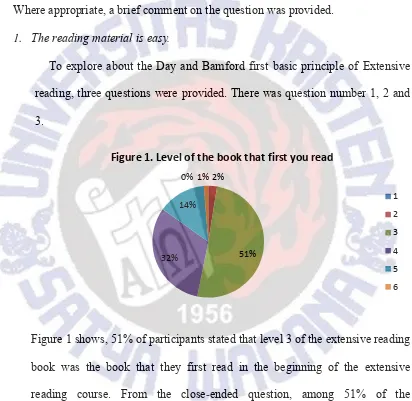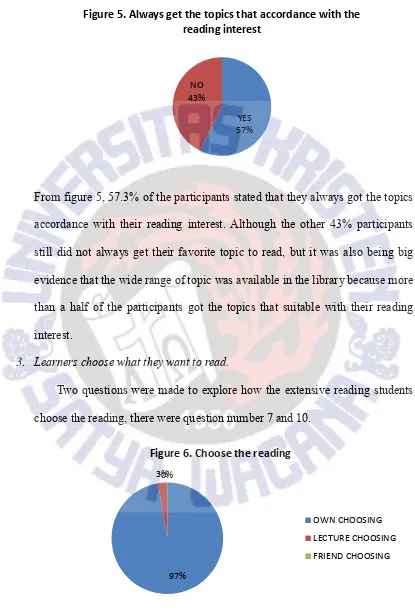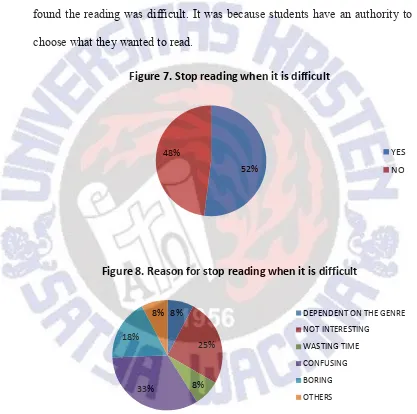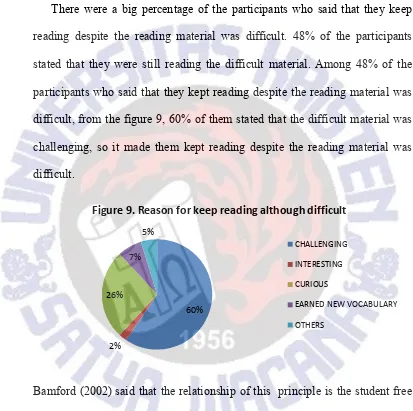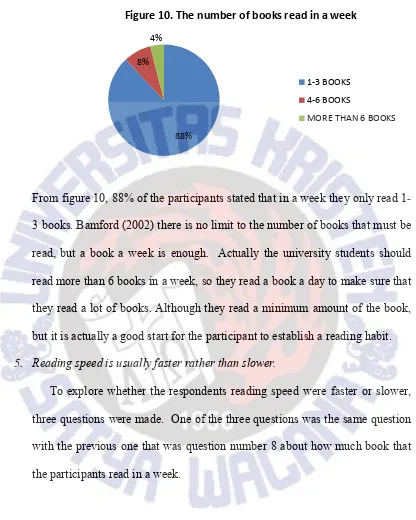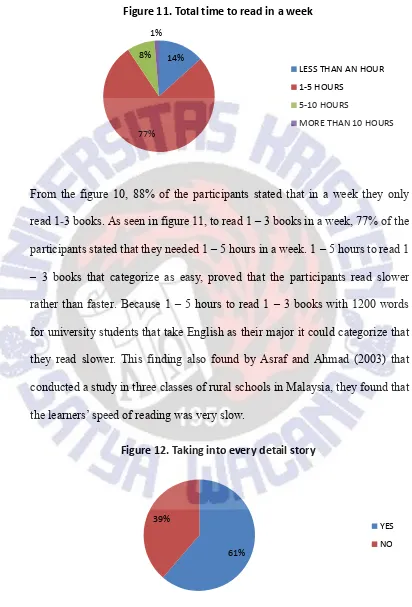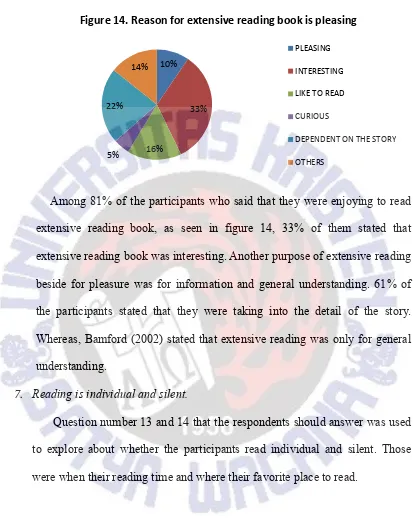THE IMPLEMENTATION OF DAY AND BAMFORD TEN
BASIC PRINCIPLES OF EXTENSIVE READING FROM
STUDENTS’ PERSPECTIVE
Aninda Mawar Intanuari
ABSTRACT
Extensive reading is a course when students should read large quantities of materials for general understanding. Based on Day and Bamford (2002) extensive reading has ten basic principles that can foster learner autonomy. This quantitative study reported on questionnaire conducted with 75 students of English Teacher Education Program (ETEP) of Satya Wacana Christian University (SWCU). The participants are 2013 students who took Extensive Reading in the odd Semester of 2013/2014. This study attempt to figure out whether the Day and Bamford ten basic principles of Extensive Reading (2002) was implemented by ETEP students of SWCU. The data show that not all the ten basic principles could have been implemented in ETEP of SWCU. The finding indicates that only seven from ten basic principles was implemented in ETEP of SWCU, there are the reading material is easy, a variety of material of a wide range of topic is available, learners choose what they want to read, reading is individual and silent, reading is its own reward, the teacher orients and guides the students and the teacher is a role model of a learner.
KEY WORDS: Extensive reading, Day and Bamford ten basic principles of Extensive Reading
INTRODUCTION
grammatical details of a reading, students focus on basic details, text is read laboriously, and usually classroom based. Whereas, based on Bamford (2004) Extensive Reading is a course that requires students to read a lot of text or a long text for global understanding, the goal is to make student enjoy to read. So, if Intensive Reading is emphasized more on linguistic capabilities, Extensive Reading is emphasized more in how to embed an interest in reading to the students.
This study will focus on the Extensive Reading course. Based on Julian Bamford and Richard R. Day (2002) who are the author of the book Extensive Reading in Second Language Classroom (Cambridge University Press), extensive reading has ten basic principles. Day and Bamford ten basic principles can succeed extensive reading program and is believed to encourage student learning autonomy. Learner autonomy is a person’s ability to learn in a more self
-governing behavior and also prepared to learn in a more self-governing method
(Holec, 1981; Little, 1991). That explanation in line with the findings of Su-Su
Hung (2011) study that Day and Bamford ten basic principles of extensive reading describes the learner independence. It means that students have an authority in their study. Although students have an authority, but still teacher should guide the students so that the students can success in extensive reading.
students also have difficulties in understanding the reading they read, they read more slowly than they read in their first language. Chang (2010) quote from Coady (1979) found that this problem arises because students often struggled to read word by word and look up the meaning in every word.
Because of these problems, this study aims to find out the extent of Day and Bamford ten Basic Principles of Extensive Reading in ETEP of SWCU. This study is necessary to determine to what extent the use of Day and Bamford ten basic principles of Extensive Reading in ETEP of SWCU. As well, this study can also answer the research question about to what extent Day and Bamford ten basic principles of Extensive Reading could be implemented by the students of ETEP of SWCU. The findings of this study are expected to help teachers think, reflect and evaluate about the Day and Bamford ten basic principles of Extensive Reading to teach Extensive Reading.
DAY AND BAMFORD TEN BASIC PRINCIPLES OF EXTENSIVE
READING
Based on Julian Bamford and Richard R. Day (2002), extensive reading has ten basic principles there are:
1. The reading material is easy.
language learning advantages increase with the number of read. So, the aim of reading material is easy based on Prowse (2002) is to make students read as much as possible.
Haider and Akhter (2012) conducted a study with 100 teachers as the participant in Dhaka city and the surrounding area in Bangladesh. To collect the data, they used a questionnaire and the respondents were selected on a purposively-random basis. They found that 26% participants
believe that their students fear reading in English. They are afraid because they think reading in English is very difficult to understand and the vocabulary is very difficult. Hu and Nation (2000) suggested that students should know at least 98% of the words in the text to understand the reading without assistance. Fry (1991) also found in his research that “beginning readers do better with easier materials” (p. 8). They read in the secure area, so they are involved in reading. Hitosugi and Day (2004) stated that read easy material helped them to learn effectively. Students know that they are able to read a foreign language, and a growing number of books read, they will see themselves as readers of the target language.
There are 6 levels of difficulty of the extensive reading book that's available in SWCU. Based on Penguin Readers book, the difficulty of the level is based on the total of the words that used. In every level also have each category that describes the difficulty of the book such as beginner, elementary, pre-intermediate, intermediate, upper-intermediate and
2. A variety of material of a wide range of topic is available.
Day and Bamford (2002) stated that the achievement of Extensive Reading count on what students’ reading enthusiasm. To boost learner reading enthusiasm, the wide range of reading materials such as books with various genres, magazines, and newspapers should be available. In addition, a difference of materials also can boost a flexible approach of reading. Because students are encouraged to read with various reasons and methods.
3. Learners choose what they want to read.
Bamford (2002) said that the relationship to this principle is students are free to choose reading, but still encouraged by the teacher, stop reading when finds difficult or uninteresting reading. Bamford statement proves that extensive reading uphold learner autonomy. It means that learners have the authority to choose the reading that they want to read. However, Haider and Akhter (2012) in their study revealed that 100% of teachers choose the story for the students and the students do not have the authority to choose the readings they read.
4. Learners read as much as possible.
The main element in learning to read is the number of books that read. Hitosugi and Day (2004) stated that the more you read, the more the benefits. As Bamford (2002) said:
It is a reasonable target for students at all levels, because books that written for beginners are very short.
5. Reading speed is usually faster rather than slower.
Bell (2001) stated that reading speed aim on the increasing methods to assist learners to read faster. Extensive reading suggests the learners to read faster rather than slower. However, Asraf and Ahmad (2003) conducted a study in three classes of rural schools in Malaysia found that the learners speed of reading was very slow. According to Bamford (2002) in addition to make students more eloquent in reading, it also encourages students to not use a dictionary when they find difficult words. Extensive reading provides an opportunity for students to keep reading, predict or avoid difficult words that they do not know and understand the reading in general.
6. The purpose of reading is usually related to pleasure, information and
general understanding.
According to Kredatusova (n.d) from Masaryk University: In spite of intensive reading, which requires detailed understanding, extensive reading encourages reading for pleasure and information. The aim of reading is not hundred percent comprehensions; to meet the purpose of reading sufficient understanding is satisfactory” (p. 11).
So, the main purpose of the reading based on Kredatusova is to find the pleasure of reading.
they read. This finding is less satisfactory since only a small percentage of students who get pleasure from extensive reading and mostly just read to be able to pass the course.
7. Reading is individual and silent.
According to Bamford (2002) extensive reading means learners reading in their steps. They read silently in the book that they choose by themselves. Extensive Reading is homework. So, it is done in the outside classroom and students read in their own time.
8. Reading is its own reward.
Bamford (2002) said that extensive reading is not pursued by understanding the questions. The aim is readers knowledge and like to read. But, teacher still can ask students to summaries or discuss the story. This is designed to give students experience in reading.
9. The teacher orients and guides the students
10.The teacher is a role model of a learner
Maley (1999) says:
We need to realize how much influence we have on our students. Students do not just (or even) learn the subject matter, we teach them; they learn from their teachers. Teacher attitude, more than technical expertise, is what they will recall when they leave us (p. 7).
The teacher can give example to students to read a novel in a class to give students motivation to read more.
Based on Macalister (2010), Day and Bamford ten Basic principles of Extensive Reading grouped into 4. There are determining the nature of the reading material (principles 1 and 2), the nature of the reading (principles 5 and 8), the learner’s behavior (principles 3 and 4) and the teacher behavior (principles 9 and 10).
From some previous studies, like Haider and Akhter (2012) and Asraf and Ahmad (2003) on the implementation of extensive reading actually almost give similar findings that the existing of the ten basic principles of extensive reading is not always used. It can be seen from Haider and Akhter (2012) studies that the learners cannot choose what they want to read because teachers control what should be read by students. Therefore, in my research, I would like to know to what extent the Day and Bamford ten basic principles of Extensive Reading actually can be used in the ETEP of SWCU.
RESEARCH DESIGN
Context of the Study
small town of Salatiga, Central Java, Indonesia. Extensive Reading in ETEP is one of the required subjects in the first semester. From Extensive Reading syllabus of odd Semester 2013/2014, Day and Bamford (2002) ten basic principles of Extensive Reading were used. This subject met for three hours every meeting in a week. The Extensive Reading reading material was available in the university library with a variety of levels and topics. The reason why the researcher used ETEP of SWCU as the context of the study was because ETEP of SWCU used Day and Bamford (2002) ten basic principles of Extensive reading as their teaching guidelines. Beside that, ETEP of SWCU was where the researcher study, so it could make the researcher easy to collect the data.
Participants
The participants of this study were 75 students who took Extensive Reading in the First Semester of 2013/2014 ETEP of SWCU. All of the participants were 2013 students that consists of 12 male and 63 female out of 100 possible students.
Instruments of Data Collection
information from each respondent because it was need their experiences from the Extensive Reading class that they enroll. The questionnaire consists of 20 questions about the implementation of the basic principles of Extensive Reading in ETEP of SWCU. Question numbers 1 - 3 address the first principle of
Extensive Reading. Questions numbers 4 - 6 address the second principle of
Extensive Reading. Question number 7 - 10 address the third principle of
Extensive Reading. Question numbers 8 - 9 address the fourth principle of
Extensive Reading. Question number 10 address the fifth principle of Extensive Reading. Question numbers 11 - 12 address the sixth principle of Extensive
Reading. Question numbers 13 - 14 address the seventh principle of Extensive
Reading. Question numbers 15 - 18 address the eighth principle of Extensive
Reading. Question number 19 address the ninth principle of Extensive Reading, and the last question, number 20 address the tenth principle of Extensive Reading. Data Collection Procedures
To make sure all the question could be answered by the participants, the researches done the piloting first. Here were some procedures of data collection:
1. The researcher looked for information about who took Extensive Reading
courses to the lecturer who teach Extensive Reading in odd Semester of 2013/2014 in ETEP of SWCU.
2. The researcher made an appointment to the respondents who are willing to
3. Researcher met the 20 respondents and asked them to fill out the
questionnaires about the implementation of ten basic principles of extensive reading based on Day and Bamford (2002) in ETEP of SWCU.
4. Researcher analyzes the question whether it can answered by the
respondents and can answer the research question. Because all the questions can be answered by the participant and can answer the research question, the researcher did not revise the questionnaire.
5. The researcher made an appointment to 75 respondents with the help of 2
lectures of Extensive Reading and for some students the researchers ask the respondents personally. The 20 respondents who filled the questionnaire for piloting were excluded.
6. Researcher met the some of the respondents in their Extensive Reading
class and the rest in the front of their class before their class started. The researcher asked them to fill out the questionnaires about the implementation of ten basic principles of extensive reading based on Day and Bamford (2002) in ETEP of SWCU.
Data Analysis Procedures
FINDINGS AND DISCUSSION
In this section, the results of the questionnaire that consist of close and open ended questions were given. The questions were discussed in ten categories based on the Day and Bamford ten basic principles of Extensive Reading (2002). Where appropriate, a brief comment on the question was provided.
1. The reading material is easy.
To explore about the Day and Bamford first basic principle of Extensive reading, three questions were provided. There was question number 1, 2 and 3.
Figure 1 shows, 51% of participants stated that level 3 of the extensive reading book was the book that they first read in the beginning of the extensive reading course. From the close-ended question, among 51% of the
participants, 93% of them stated that level three was easy to understand. Based on Penguin Readers books, book level 3 contains around 1200 words and categorize as Pre-intermediate. Pre-Intermediate book for beginner
EFL university student was enough because the word of the book was not
0% 2%
51% 32%
14% 1%
Figure 1. Level of the book that first you read
1
2
3
4
5
simple but also not really difficult to understand. Because level 3 was categorized as easy, it is like what Fry (1991) suggests that beginning readers do better with easier materials.
As seen in figure 2, 96% of the participants stated that they increase their level of book. Among 96% of the participants, 26% of them stated the increasing level was because they want to increase their vocabulary knowledge it could be seen in figure 3. Whereas, 22% of the participants stated that reading has become their habit (accustomed) so they tried to increase their book level. The result of this study was in line with Day and
YES 96% NO 4%
Figure 2. Increasing levels from beginning to the end of the course
Bamford (1998) quoted from Richards, Platt, and Platt (1992) that “extensive reading is intended to develop good reading habits, to build up knowledge of vocabulary and structure, and to encourage a liking for reading” (p. 193-194).
2. A variety of material on a wide range of topic is available.
Two questions were provided to explore to what extend a wide range of materials was available based on the students' perception. There was question number 5 and 6.
From figure 4, 65% of the participants stated that the book in the library was various enough. Whereas, the other 35% of the participants stated that the library was not various enough.
YES 65% NO
35%
From figure 5, 57.3% of the participants stated that they always got the topics accordance with their reading interest. Although the other 43% participants still did not always get their favorite topic to read, but it was also being big evidence that the wide range of topic was available in the library because more than a half of the participants got the topics that suitable with their reading interest.
3. Learners choose what they want to read.
Two questions were made to explore how the extensive reading students choose the reading, there were question number 7 and 10.
YES 57% NO
43%
Figure 5. Always get the topics that accordance with the reading interest
97% 3% 0%
Figure 6. Choose the reading
OWN CHOOSING
LECTURE CHOOSING
52% 48%
Figure 7. Stop reading when it is difficult
YES
NO As seen in figure 6, 97% of participants stated that they choose what they wanted to read by themselves. Only 3% of the participants who stated that their teacher chose the reading for them.
The principle number 3 also suggests the learners to stop reading if they found the reading was difficult. It was because students have an authority to choose what they wanted to read.
However, from the figure 7 reveal that only 52% of the participants stated that they stopped reading when they thought the reading was difficult. Among the 52% of the participants who said that they stopped reading when the reading
8%
25%
8% 33%
18% 8%
Figure 8. Reason for stop reading when it is difficult
DEPENDENT ON THE GENRE
NOT INTERESTING
WASTING TIME
CONFUSING
BORING
was difficult, as seen in figure 8, 33% of the them stated that they were confused with the story. The other 25% of the participants stated that the difficult reading made the reading become not interesting.
There were a big percentage of the participants who said that they keep reading despite the reading material was difficult. 48% of the participants stated that they were still reading the difficult material. Among 48% of the participants who said that they kept reading despite the reading material was difficult, from the figure 9, 60% of them stated that the difficult material was challenging, so it made them kept reading despite the reading material was difficult.
Bamford (2002) said that the relationship of this principle is the student free to stop reading when they find the reading is difficult or uninteresting.
4. Learners read as much as possible.
To explore whether learners could read as much as possible, question number 8 was made.
60%
2% 26%
7% 5%
Figure 9. Reason for keep reading although difficult
CHALLENGING
INTERESTING
CURIOUS
EARNED NEW VOCABULARY
From figure 10, 88% of the participants stated that in a week they only read 1
-3 books. Bamford (2002) there is no limit to the number of books that must be read, but a book a week is enough. Actually the university students should read more than 6 books in a week, so they read a book a day to make sure that they read a lot of books. Although they read a minimum amount of the book, but it is actually a good start for the participant to establish a reading habit.
5. Reading speed is usually faster rather than slower.
To explore whether the respondents reading speed were faster or slower, three questions were made. One of the three questions was the same question with the previous one that was question number 8 about how much book that the participants read in a week.
88% 8%
4%
Figure 10. The number of books read in a week
1-3 BOOKS
4-6 BOOKS
From the figure 10, 88% of the participants stated that in a week they only read 1-3 books. As seen in figure 11, to read 1 – 3 books in a week, 77% of the
participants stated that they needed 1 – 5 hours in a week. 1 – 5 hours to read 1 – 3 books that categorize as easy, proved that the participants read slower rather than faster. Because 1 – 5 hours to read 1 – 3 books with 1200 words for university students that take English as their major it could categorize that they read slower. This finding also found by Asraf and Ahmad (2003) that conducted a study in three classes of rural schools in Malaysia, they found that the learners’ speed of reading was very slow.
14%
77% 8%
1%
Figure 11. Total time to read in a week
LESS THAN AN HOUR
1-5 HOURS
5-10 HOURS
MORE THAN 10 HOURS
61% 39%
Figure 12. Taking into every detail story
YES
They read slowly was probably because the participants tend to take into the detail story. As seen in figure 12, it was proved by 61% of the participants who stated that they were taking into the detail of the story. Whereas, Bamford (2002) in addition to make students more fluent reading, it also encourages students to not use a dictionary when they find difficult words. Extensive reading provides an opportunity for students to keep reading, guess or ignore difficult words that they do not know and understand the reading in general.
6. The purpose of reading is usually related to pleasure, information and general
understanding.
Question number 11 and 12 were made to explore about whether the purpose of reading was related to pleasure, information and general understanding.
From figure 13, 81% of the respondents stated that they were pleased to read extensive reading books.
81% 19%
Figure 13. Extensive reading book is pleasing
YES
Among 81% of the participants who said that they were enjoying to read extensive reading book, as seen in figure 14, 33% of them stated that extensive reading book was interesting. Another purpose of extensive reading beside for pleasure was for information and general understanding. 61% of the participants stated that they were taking into the detail of the story. Whereas, Bamford (2002) stated that extensive reading was only for general understanding.
7. Reading is individual and silent.
Question number 13 and 14 that the respondents should answer was used to explore about whether the participants read individual and silent. Those were when their reading time and where their favorite place to read.
10%
33%
16% 5%
22% 14%
Figure 14. Reason for extensive reading book is pleasing
PLEASING
INTERESTING
LIKE TO READ
CURIOUS
DEPENDENT ON THE STORY
Based on figure 15, around Fifty six participants (56%) stated that they were reading in their spare time. The other 23% of the participants stated that they read at night before they slept.
2%
Figure 16. Have a favorite reading place
85% 6%
7% 2%
Figure 17. Favorite place to read
BEDROOM
QUIET PLACE
LIBRARY
From figure 16, 75% of the participants stated that they had a favorite place to read. Their favorite place to read was their bedroom; it was stated by 85% of participants in figure 17. They read in their bedroom before they sleep indicate that they read individually because the bedroom was a private place for some people. All of the participants also choose place for reading that quietly like the bedroom and the library because they wanted to read silently.
8. Reading is its own reward
Question number 18 was provided to analyze about reading was its own reward. As seen in figure 18, among 50% of the participant stated that they were increasing their vocabulary knowledge after they enroll the extensive reading class. Besides the increasing of vocabulary, their speaking and writing skill were also increasing. The increasing speaking ability was stated by 12% of the participants and among 9% of the participants stated that their writing skill was increasing.
This finding was in line with Maley (2002) statement that the reward or benefit of extensive reading helps develop general world knowledge, keep up
6%
Figure 18. Experiences about the increasing skills
63% 37%
Figure 19. Lecture guide the student to find the reading
YES
NO vocabulary growth and helps improve writing.
9. The teacher orients and guides the students
Question number 19 was made to explore whether their teacher guides the students. As seen in figure 19, 63% of the participants stated that their teacher helped them to find the reading material.
The teacher helped students find the reading topics that suitable with their reading interest not choose the reading that should be read. Teachers should guide the students from beginning to the end of the course. Kredatusova (n.d) stated:
Before starting an extensive reading program, students have to be familiar with what it is, why they are doing it, what benefits it will bring them and how are they going to proceed. Teachers can keep track of what and how much each student reads, and their students' reactions to what was read (p. 11).
10.The teacher is a role model of a learner
class.
By giving an example to read in class, students would be encouraged to read extensive reading book. Maley (1999) said that:
Teacher needs to realize how much influence they have on their students. Students do not just (or even) learn the subject matter teacher teach them; they learn from their teachers. Teacher attitude, more than technical expertise, is what they will recall when they leave the teacher (p. 7).
To make easier, this discussion used Macalister (2010) grouping for Day and Bamford ten basic principles of extensive reading. They are determining the nature of the reading material (1 and 2), the nature of the reading (5 – 8), the learner's behavior (3 and 4) and the teacher behavior (9 and 10).
A. The Nature of the Reading Material
1. The reading material is easy.
Extensive reading suggests the learners to read the reading material that's easy to understand. Even Hu and Nation (2000) suggested that students should know at least 98% of the words in the text to understand the reading without assistance. This study proves that the learners tend to
71% 29%
Figure 20. Lecture give example to read extensive reading material in class
YES
Learners tend to read the book based on the level of the book that they think was easy to understand. They chose book level three as the book that's easy for them. However, as the university student who take English as their major, level three was not enough for them because level three categorized as pre-intermediate and only consist of around 1200 words.
How could university students who took English as their major thought that read more than 1200 words is difficult?
2. A variety of material of a wide range of topic is available.
Extensive reading also suggest about the variety of material on a wide range of topic should available. Bamford (2002) stated that the success of extensive reading depends on what students’ interest in reading. To encourage learner interest in reading, the wide range of reading materials such as books with various genres, magazines, and newspapers should be available. Based on this study reveal that the various topics of the book available in the university library. They (57% of the participants) also always got the topics of the reading that suits with their reading interest. On the other hand the 43% of the participants who did not always get the topics that accordance with their reading interest will thought that in the library the material was not various enough.
B. The Nature of the Reading
1. Reading speed is usually faster rather than slower
tend to open dictionary to find the words that they did not know. It was shown from this study and study that conducted by Asraf and Ahmad (2003) in three classes of rural schools in Malaysia.
2. The purpose of reading is usually related to pleasure, information and
general understanding.
Day and Bamford (2002) stated reading aim is for pleasure, informational and general understanding. Haider and Akhter (2012) found out only 21% of their participants said that they got pleasure while they read. The result was different with this study result, because 81% of the participants stated that they enjoyed reading the extensive reading book. However, 61% of the participants still taking into the detail story so, they were not reading for general understanding.
3. Reading is individual and silent.
Bamford (2002) stated that Extensive Reading means reading in learner steps. The result of this study proves that learners read individually and silently. It was shown from 85% of the participants choose their own bedroom as their favorite place to read extensive reading book.
4. Reading is its own reward.
C. The Learners Behavior
1. Learners choose what they want to read.
In this study reveal that learners tend to read the minimum quantity of the book a week. They just read 1- 3 books in a week, although
Bamford (2002) said a week a book is enough to improve reading habit. But, it was still lacking for the university student, as the university student who take the extensive reading course they should at least read a book a day to make sure they read a lot. Actually, this problem happened because students had an authority to choose and how much book they wanted to read.
2. Learners read as much as possible.
Besides the authority about how much book that they wanted to read a week, students also had an authority to choose the reading that they wanted to read. However, Haider and Akhter (2002) research revealed that 100% of teachers said, they chose the story to the students and the students did not have the authority to choose the readings they read. But, in this study learners were free to choose the reading that they wanted to read, although they were read in the minimum amount of book in a week.
D. Teacher’s behavior
1. The teacher orients and guides the students.
students to choose reading that suit with the learner’s interest. It was shown from more than a half of the participants in this study stated that their teacher guided them to choose the reading that suitable with their reading interest.
2. The teacher is a role model of a learner.
Maley (1999) said, "We need to realize how much influence we had on our students” (p. 7). The teacher should guide and give example to the students by being a role model for the students to get a better result. This study was in line with what Maley said, because it was revealed that their teacher gave the participant example to read a novel or reading in class to encourage them to read a lot.
CONCLUSION
variety of of material on a wide range of topics were available.
Day and Bamford ten basic principle number 5 – 8 were used to analyze about the nature of the reading. Because students were reading slower rather than faster and they were reading not for general understanding, only two from 4 basic principles that could be implemented. Students still influences with intensive reading that students need to took into detail story. The other two principles could implement because students were still reading individually and silently. Students’ vocabulary also increasing after they enroll an extensive reading class, this could be a prove that reading was its own reward.
To analyze about the learner behavior, Day and Bamford ten basic principles of Extensive Reading number 3 and 4 were used. From this study revealed that the students could choose the reading by themselves, the teacher did not have an authority to choose the reading for the students. But, students tended to read the minimum amount of books to read in a week. They read only 1 – 3 books in a week, despite reading as much as possible.
The last was about the teacher’s behavior. To analyze about the teacher behavior, Day and Bamford ten basic principle number 9 and 10 were used. It was revealing the both basic principles were implemented in ETEP of SWCU. This was shown from teacher guide the students to find topics that suitable with students’ reading interest and teachers gave an example to read novel in front of the class as a role model.
ETEP of SWCU. Only seven from the ten basic principles of Extensive Reading by Day and Bamford (2002) that could implement. Hence, the result of this study could help the Extensive Reading teacher to evaluate the use of Day and Bamford ten basic principles of Extensive Reading in the Extensive Reading course.
As mentioned earlier, to investigate whether the Day and Bamford ten basic principles could be implemented in ETEP of SWCU, the questionnaire that included close and open ended question was used. Because of the time limitation, the researcher only used one methodology. In order to get more data, in the next study, the researcher should know more about the teacher’s role in the Extensive Reading course. For the future study, the researcher hopes another methodology such as class observation and interview are used. Also, the researcher believes that the other methodologies help researcher to get more data to be analyzed.
REFERENCES:
Asraf. R.M & Ahmad. I. S. (2003). Promoting english language development and the reading habit among students in rural school habit among students through the guided extensive reading program. Reading in a foreign
language, 15(2). Retrieved from
http://www.nflrc.hawaii.edu/rfl/October2003/mohdasraf/mohdasraf.htm
Bamford, J, & Day. R. R. (2004). Extensive reading activities for teaching language, Cambridge University Press.
Bell, T. (2001). Extensive reading: Speed and comprehension. The reading matrix, 1(1). Retrieved from www.readingmatrix.com/articles/bell/
Brown, D.S (1989). A world of books: An annotated reading list for ESL/EFL students (2nd ed). Washington, DC: Teachers of English to Speakers of
other Languages.
Day, R. R & Bamford. J. (1998). Extensive reading in the second language classroom. Cambridge University Press.
Day, R. R. & Bamford, J. (2002). Top ten principles for teaching extensive reading.Reading in a foreign language,14(2). Retrieved from http://nflrc.hawaii.edu/rfl/October2002/day/day.html
Fry, E. (1991). Ten best ideas for reading teachers. In E. Fry (Ed.), Ten best ideas for reading teachers (pp. 6-16). Menlo Park, Calif.: Addison-Wesley.
Haider, M. Z & Akhter, E. (2012). Extensive reading in EFL classroom at secondary school in Bangladesh: Current practices and future possibilities. International Educational Studies. retrieved From www.ccsenet.org/journal/index.php/ies/article/download/9853/11510 Henry, J. (1995). If not now: Developmental readers in the college classroom.
Portsmouth, NH: Boynton/Cook, Heinemann
Hitosugi. C. I & Day. R. R. (2004). Extensive reading in Japanese. University of Hawai’i. Reading in a foreign language, 16(1). Retrieved from http://nflrc.hawaii.edu/rfl/April2004/hitosugi/hitosugi.html
Holec, H. (1981). Autonomy and foreign language learning. Oxford: Pergamon. Hu, M. & Nation, P. (2000). Unknown vocabulary density and reading
comprehension. Reading in a Foreign Language, 13(1), 403-430.
Jared. T & John. P. (2014). 7 Mistakes about extensive reading. Mandarin Companion. Retrieved from http://mandarincompanion.com/blog/7
Kredatusova, M. (n.d.). The Benefits of extensive reading in EFL. Masaryk University. Retreived from
http://is.muni.cz/th/152953/pedf_b/bakalarska_prace.pdf
Little, D. (1991). Learner Autonomy 1: Definitions, issues and problems. Dublin: Authentik.
Macalister. J (2010). Investigating teacher attitudes to extensive reading practices in Honger education: Why isn’t everyone doing it?. RELC Journal. Retrieved from http://rel.sagepub.com/content/41/1/59
MacLeod, M. (n.d). Types of reading. Retrieved from http://fis.ucalgary.ca/Brian/611/readingtype.html#intensivereading Maley, A. (1999). Surviving the 20th century. English Teaching Professional, 10,
3-7
Maley. A. (2009). Extensive reading: why it is good for our students… and for us.
British Council. Retrieved from
https://www.teachingenglish.org.uk/article/extensive-reding-why-it
-good-our-students%E2%80%A6-us
Nuttall. C. (1982). Teaching reading skills in a foreign language. Oxford: Heinemann.
Nuttall, C. (1996). Teaching reading skills in a foreign language (2nd ed.). Oxford: Heinemann.
Prowse, P. (2002). Top ten principles for teaching extensive reading: A response. Reading in foreign language, 14(2). Retreived from http://nflrc.hawaii.edu/rfl/october2002/discussion/prowse.html
Su-Su.H. (2011). Extensive Reading For Undergraduate EFL Learners:
Multimodal text Vs. Linear text. Washington State University.
ACKNOWLEDGEMENT
This thesis would not have been accomplished without supports from many people. Firstly, I thank to Allah. He blessed me with health and energy to struggle to do my best. Thank you Ibu Anita Kurniawati, M. Hum my supervisor for her patience, guidance and assistance, my examiner Ibu Anne I. Timotius, M.Ed for her kindness.
I should thank to my parents, my brothers and my sister for their support and patient. I would also like to thank to all the participants for my thesis for their time and helpfulness. I wish to thank to all my friends, Ika, Ekky, Dicta, Desi, Jojo, Lintar and those whose name I could not mention, thank you for the support, friendship, laughter, and kindness.
Finally, I am grateful to ETEP of SWCU and all the lectures for their knowledge. I will miss the moment that I have spent during my study.
Thank you.
